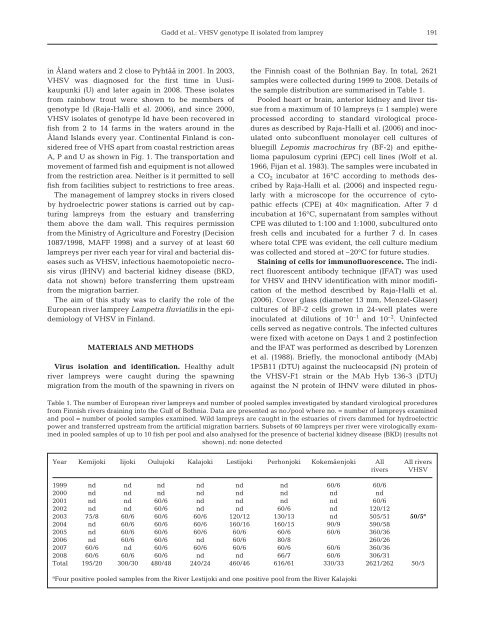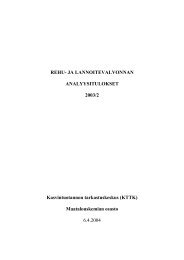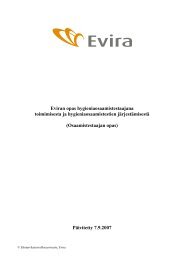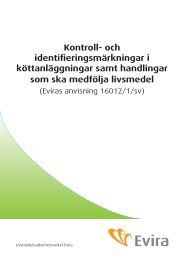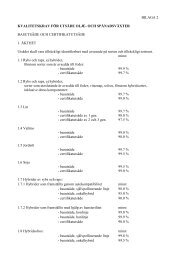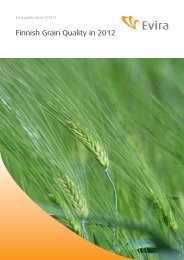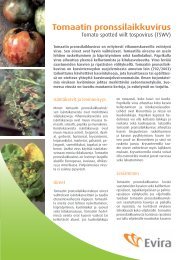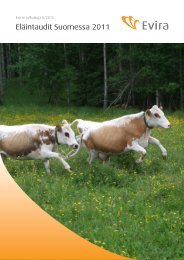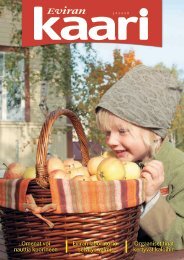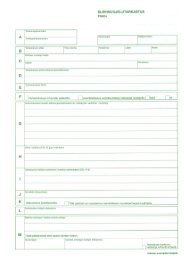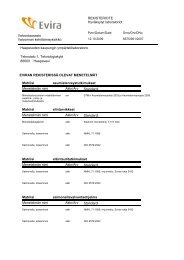Dis Aquat Org - Inter Research
Dis Aquat Org - Inter Research
Dis Aquat Org - Inter Research
You also want an ePaper? Increase the reach of your titles
YUMPU automatically turns print PDFs into web optimized ePapers that Google loves.
in Åland waters and 2 close to Pyhtää in 2001. In 2003,<br />
VHSV was diagnosed for the first time in Uusikaupunki<br />
(U) and later again in 2008. These isolates<br />
from rainbow trout were shown to be members of<br />
genotype Id (Raja-Halli et al. 2006), and since 2000,<br />
VHSV isolates of genotype Id have been recovered in<br />
fish from 2 to 14 farms in the waters around in the<br />
Åland Islands every year. Continental Finland is considered<br />
free of VHS apart from coastal restriction areas<br />
A, P and U as shown in Fig. 1. The transportation and<br />
movement of farmed fish and equipment is not allowed<br />
from the restriction area. Neither is it permitted to sell<br />
fish from facilities subject to restrictions to free areas.<br />
The management of lamprey stocks in rivers closed<br />
by hydroelectric power stations is carried out by capturing<br />
lampreys from the estuary and transferring<br />
them above the dam wall. This requires permission<br />
from the Ministry of Agriculture and Forestry (Decision<br />
1087/1998, MAFF 1998) and a survey of at least 60<br />
lampreys per river each year for viral and bacterial diseases<br />
such as VHSV, infectious haemotopoietic necrosis<br />
virus (IHNV) and bacterial kidney disease (BKD,<br />
data not shown) before transferring them upstream<br />
from the migration barrier.<br />
The aim of this study was to clarify the role of the<br />
European river lamprey Lampetra fluviatilis in the epidemiology<br />
of VHSV in Finland.<br />
MATERIALS AND METHODS<br />
Virus isolation and identification. Healthy adult<br />
river lampreys were caught during the spawning<br />
migration from the mouth of the spawning in rivers on<br />
Gadd et al.: VHSV genotype II isolated from lamprey<br />
191<br />
the Finnish coast of the Bothnian Bay. In total, 2621<br />
samples were collected during 1999 to 2008. Details of<br />
the sample distribution are summarised in Table 1.<br />
Pooled heart or brain, anterior kidney and liver tissue<br />
from a maximum of 10 lampreys (= 1 sample) were<br />
processed according to standard virological procedures<br />
as described by Raja-Halli et al. (2006) and inoculated<br />
onto subconfluent monolayer cell cultures of<br />
bluegill Lepomis macrochirus fry (BF-2) and epithelioma<br />
papulosum cyprini (EPC) cell lines (Wolf et al.<br />
1966, Fijan et al. 1983). The samples were incubated in<br />
a CO 2 incubator at 16°C according to methods described<br />
by Raja-Halli et al. (2006) and inspected regularly<br />
with a microscope for the occurrence of cytopathic<br />
effects (CPE) at 40× magnification. After 7 d<br />
incubation at 16°C, supernatant from samples without<br />
CPE was diluted to 1:100 and 1:1000, subcultured onto<br />
fresh cells and incubated for a further 7 d. In cases<br />
where total CPE was evident, the cell culture medium<br />
was collected and stored at –20°C for future studies.<br />
Staining of cells for immunofluorescence. The indirect<br />
fluorescent antibody technique (IFAT) was used<br />
for VHSV and IHNV identification with minor modification<br />
of the method described by Raja-Halli et al.<br />
(2006). Cover glass (diameter 13 mm, Menzel-Glaser)<br />
cultures of BF-2 cells grown in 24-well plates were<br />
inoculated at dilutions of 10 –1 and 10 –2 . Uninfected<br />
cells served as negative controls. The infected cultures<br />
were fixed with acetone on Days 1 and 2 postinfection<br />
and the IFAT was performed as described by Lorenzen<br />
et al. (1988). Briefly, the monoclonal antibody (MAb)<br />
1P5B11 (DTU) against the nucleocapsid (N) protein of<br />
the VHSV-F1 strain or the MAb Hyb 136-3 (DTU)<br />
against the N protein of IHNV were diluted in phos-<br />
Table 1. The number of European river lampreys and number of pooled samples investigated by standard virological procedures<br />
from Finnish rivers draining into the Gulf of Bothnia. Data are presented as no./pool where no. = number of lampreys examined<br />
and pool = number of pooled samples examined. Wild lampreys are caught in the estuaries of rivers dammed for hydroelectric<br />
power and transferred upstream from the artificial migration barriers. Subsets of 60 lampreys per river were virologically examined<br />
in pooled samples of up to 10 fish per pool and also analysed for the presence of bacterial kidney disease (BKD) (results not<br />
shown). nd: none detected<br />
Year Kemijoki Iijoki Oulujoki Kalajoki Lestijoki Perhonjoki Kokemäenjoki All All rivers<br />
rivers VHSV<br />
1999 nd nd nd nd nd nd 60/6 60/6<br />
2000 nd nd nd nd nd nd nd nd<br />
2001 nd nd 60/6 nd nd nd nd 60/6<br />
2002 nd nd 60/6 nd nd 60/6 nd 120/12<br />
2003 75/8 60/6 60/6 60/6 120/12 130/13 nd 505/51 50/5 a<br />
2004 nd 60/6 60/6 60/6 160/16 160/15 90/9 590/58<br />
2005 nd 60/6 60/6 60/6 60/6 60/6 60/6 360/36<br />
2006 nd 60/6 60/6 nd 60/6 80/8 260/26<br />
2007 60/6 nd 60/6 60/6 60/6 60/6 60/6 360/36<br />
2008 60/6 60/6 60/6 nd nd 66/7 60/6 306/31<br />
Total 195/20 300/30 480/48 240/24 460/46 616/61 330/33 2621/262 50/5<br />
a Four positive pooled samples from the River Lestijoki and one positive pool from the River Kalajoki


